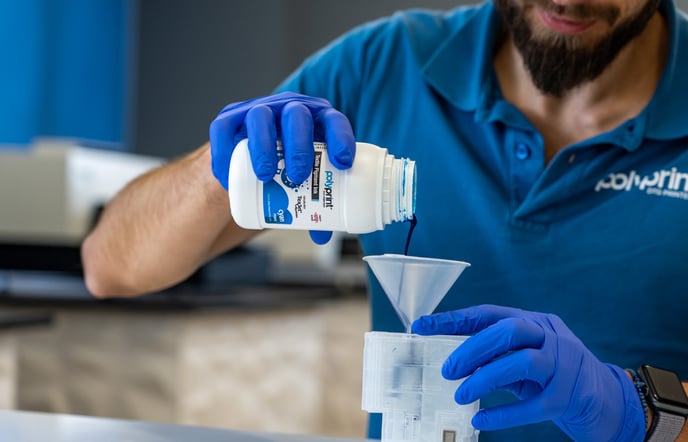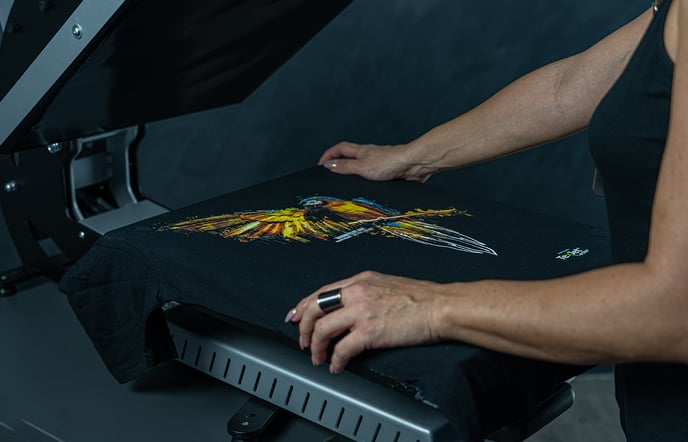Learn all about why DTG printing is considered one of the most environmentally friendly approaches in the textile industry.
Through the years the clothing industry has evolved, in order to provide better quality and larger quantities, it has adapted to fashion trends, and kept up with current technology innovations. Different raw materials, substrates and techniques have been used since the beginning, paving the way to one of the latest methods of textile making: Direct to Garment (DTG) printing.
Direct to garment printing, as the name suggests, is a textile process that prints the design directly to the fabric using inkjet technology. DTG has become one of the most convenient methods of garment decoration, marking its entry to the market by having the most sustainable and eco-friendly approach. This environmental contribution is responding to the rising demand for more ecologically conscious textile production.
The fashion industry is considered one of the largest polluters globally, as it produces about 20% of the world’s wastewater and is accountable for 10% of global greenhouse gas emissions. Annually, over 150 billion garments are produced, while each American disposes approximately 32 kg and the average European about 11 kg of fabrics per year. DTG printing recognized the environmental impact that common textile practices can have and came through with a responsible solution. Here are the reasons why Direct to Garment printing is considered the most sustainable approach:
Water-based inks
 DTG technology uses water-based pigment inks that consist of mainly water, making them an excellent candidate for biodegradable decomposition. These inks are considered eco-friendlier when in comparison with other inks and dyes, as they contain natural pigments and environmentally-friendly chemical additives that have little to none VOCs emission.
DTG technology uses water-based pigment inks that consist of mainly water, making them an excellent candidate for biodegradable decomposition. These inks are considered eco-friendlier when in comparison with other inks and dyes, as they contain natural pigments and environmentally-friendly chemical additives that have little to none VOCs emission.
Why you should always use manufacturer-approved inks
Natural fabrics oriented
DTG printing can cover a wide spectrum of fabric types, from cotton, blends and even pure synthetics when combined with other methods (DTF). That being said, it performs better on natural fibers like cotton, linen, hemp and leather. Organic cotton is actually one of the most sustainable choices for dtg printing.
 Choosing a natural fiber over a synthetic one can have a great environmental impact. The biodegradability of the fabric can be vast from a few weeks (natural fibers) to even 200 years (i.e polyester) when composted. Also, when washing synthetic fabrics tons of microfibers are released in the ocean putting marine life at risk. DTG technology was developed around the natural fabric movement, making the process more responsible and sustainable.
Choosing a natural fiber over a synthetic one can have a great environmental impact. The biodegradability of the fabric can be vast from a few weeks (natural fibers) to even 200 years (i.e polyester) when composted. Also, when washing synthetic fabrics tons of microfibers are released in the ocean putting marine life at risk. DTG technology was developed around the natural fabric movement, making the process more responsible and sustainable.
What types of fabrics are suitable for dtg printing?
User-friendly
The working conditions in a dtg workspace are considered one of the safest choices in the textile industry, as the printer operator doesn’t come in contact with hazardous chemicals. As mentioned before, the inks and pretreatment liquids used are water-based, with certifications that declare that are not harmful for human help. The inks are kept in closed cartridges at all times and the pretreatment solutions are sprayed within closed chambers, making the air that the user breathes as safe as possible.
Texjet Inks: OEKO TEX - ECO PASSPORT certification
No aftertreatment
 When in comparison with other printing or dyeing methods, dtg garments don’t require an aftertreatment process. In the clothing industry, most textiles after their original treatment need a large amount of water and detergent to remove chemicals and additives, such as softener, to provide the desired feel. A dtg printed garment is ready-to-wear after its curing.
When in comparison with other printing or dyeing methods, dtg garments don’t require an aftertreatment process. In the clothing industry, most textiles after their original treatment need a large amount of water and detergent to remove chemicals and additives, such as softener, to provide the desired feel. A dtg printed garment is ready-to-wear after its curing.
Less waste
DTG printing is mostly an automatic process, requiring minimum user handling and this way, giving consistent, high quality prints. During production the chance of a mistake is limited, as if you perform the printer maintenance correctly and you have set the software parameters properly, the printed outcome will be perfect every time. This way, textile and ink waste is minimized keeping the standards for the eco-friendly processes up. In addition, most dtg printers have regulated the ink waste during the cleaning cycle to the minimum, in order not pollute the environment with unnecessary waste.
-1.png?height=120&name=Polyprint%20Logo%20(Dark)-1.png)